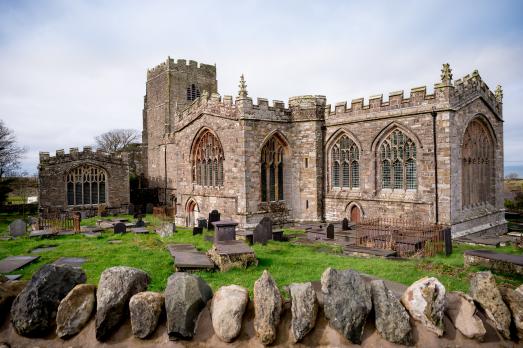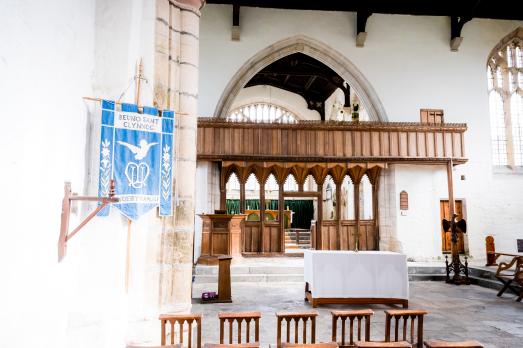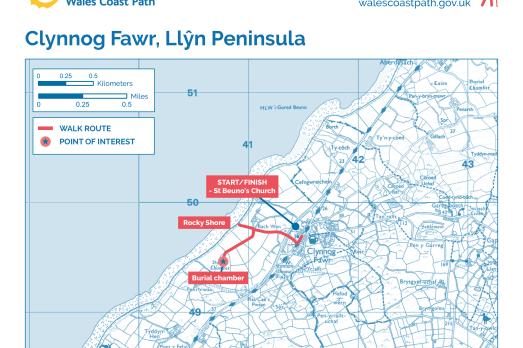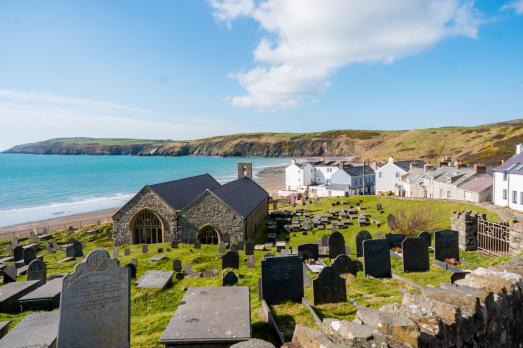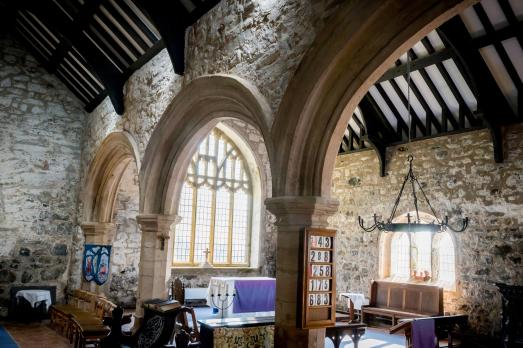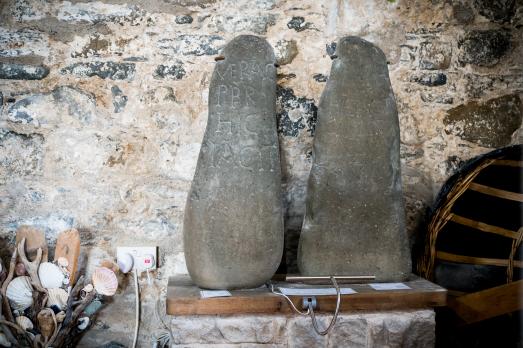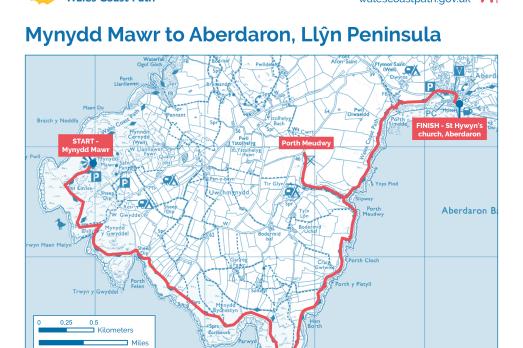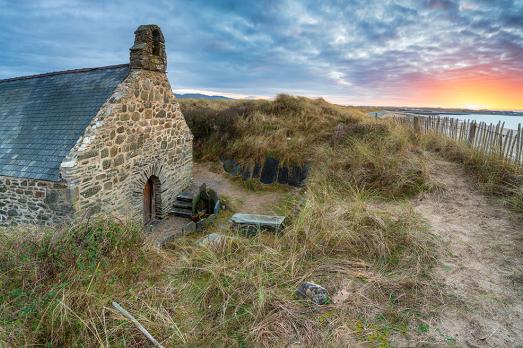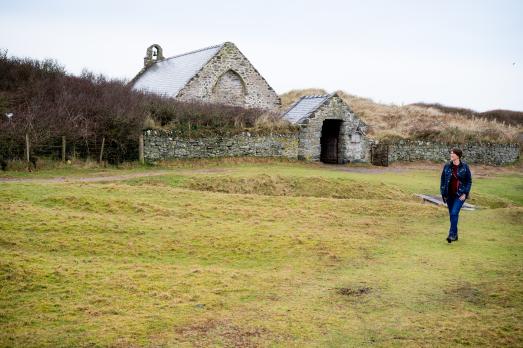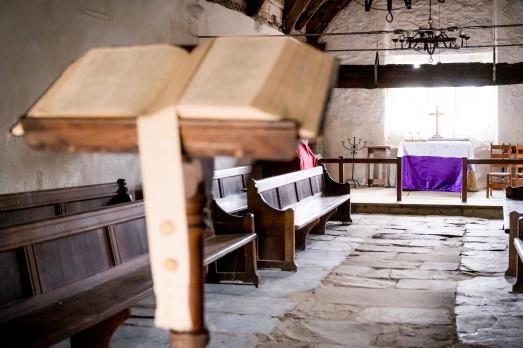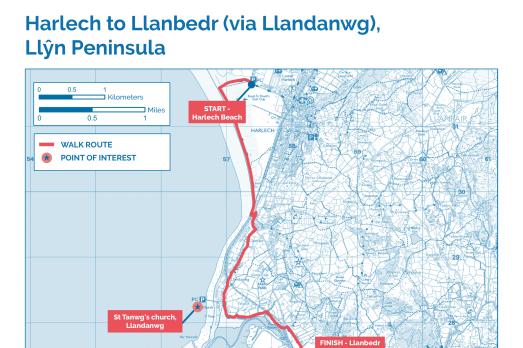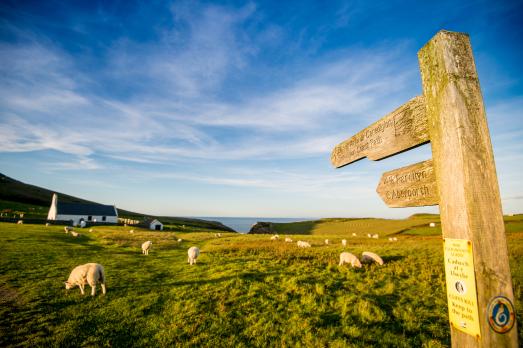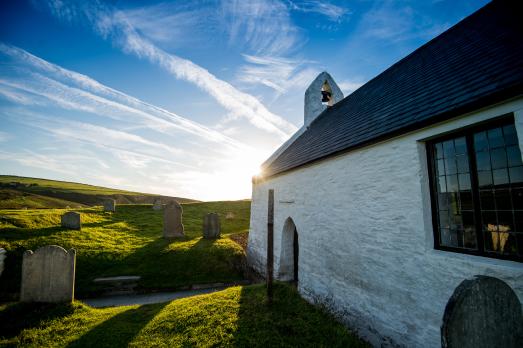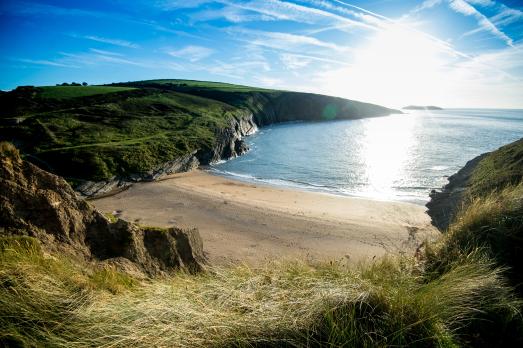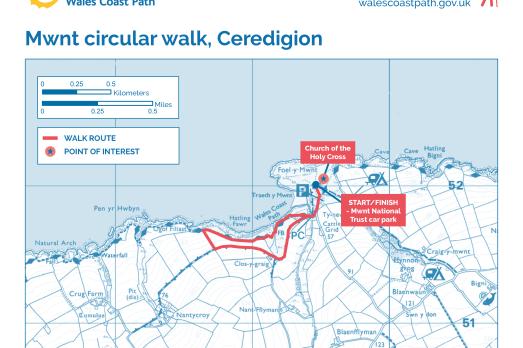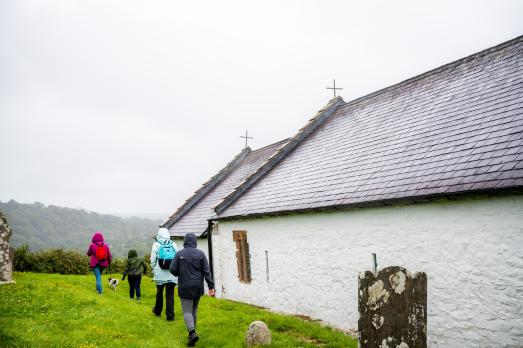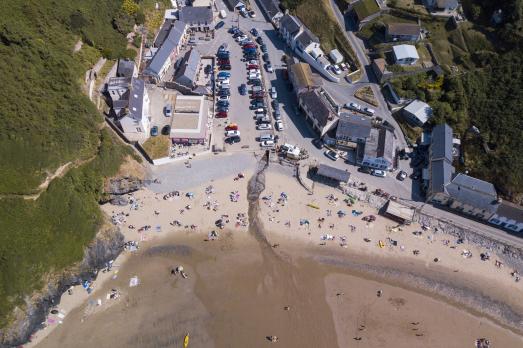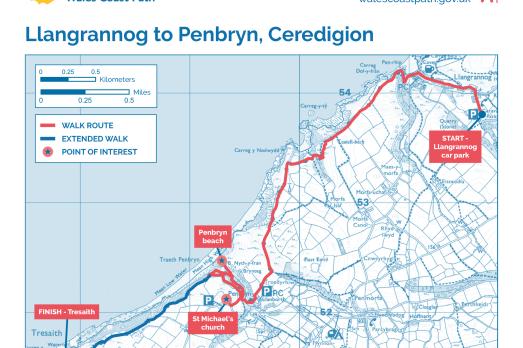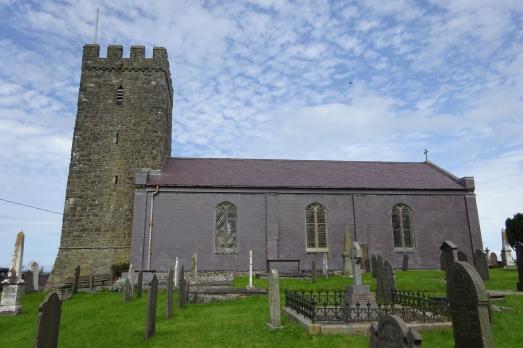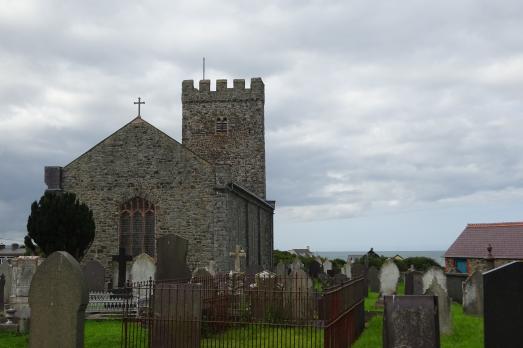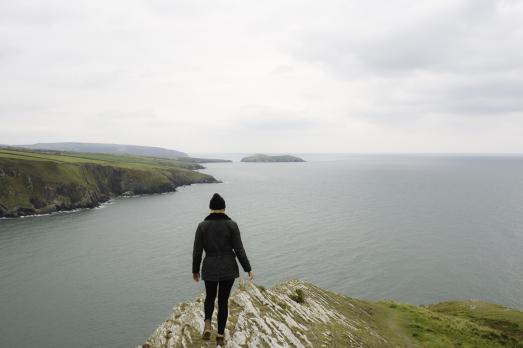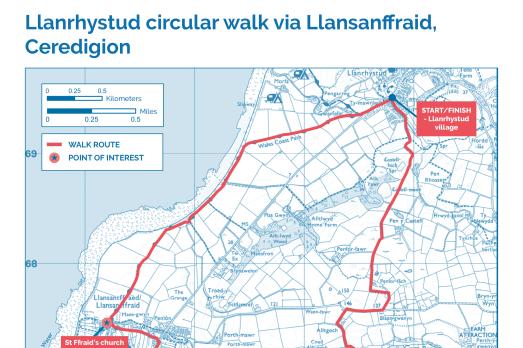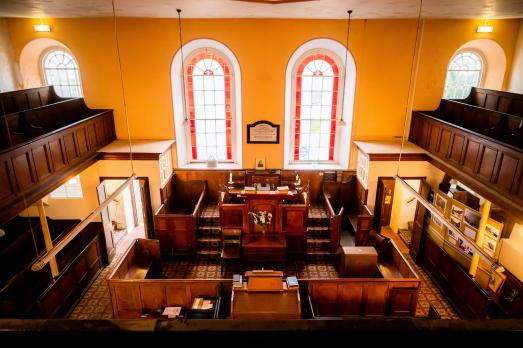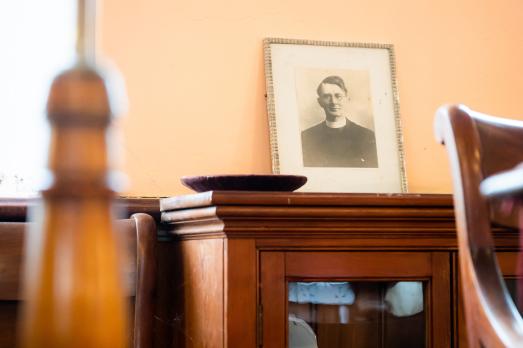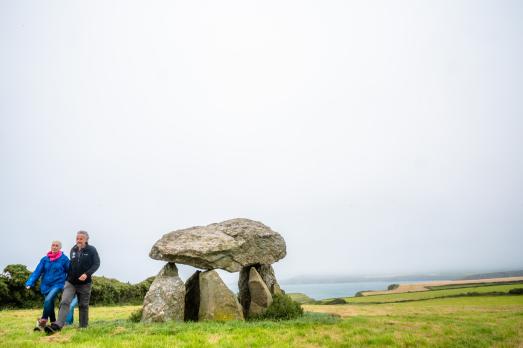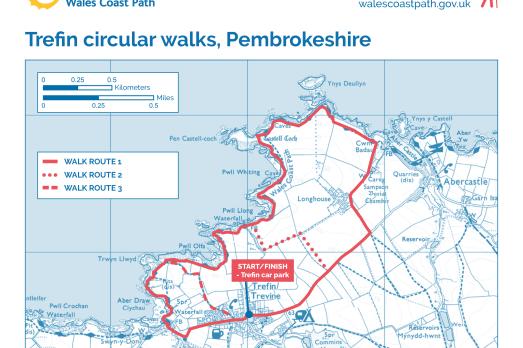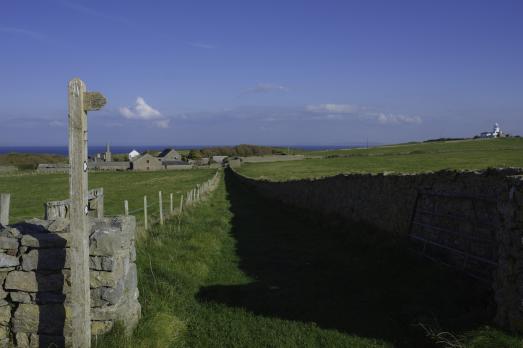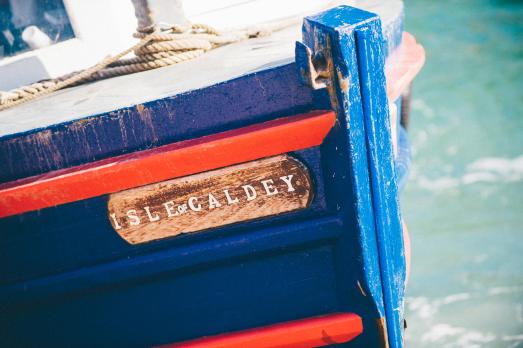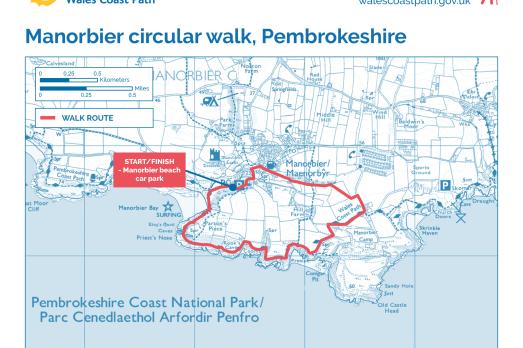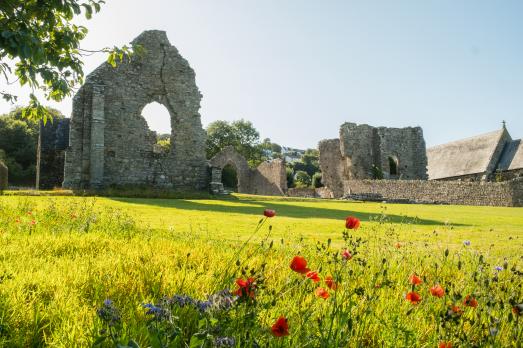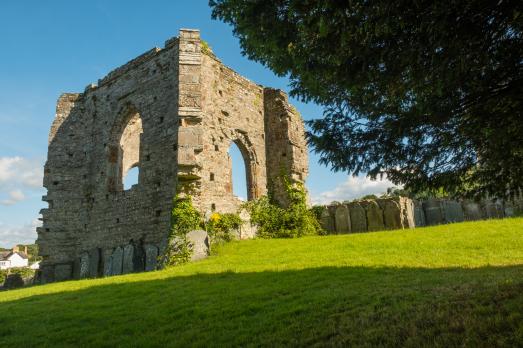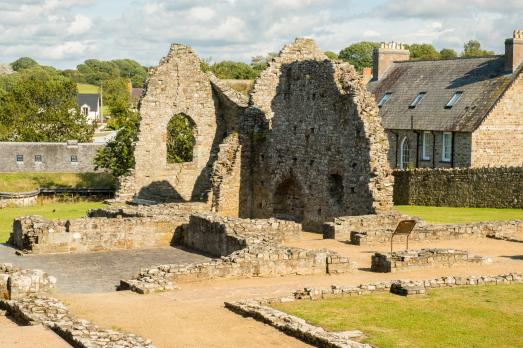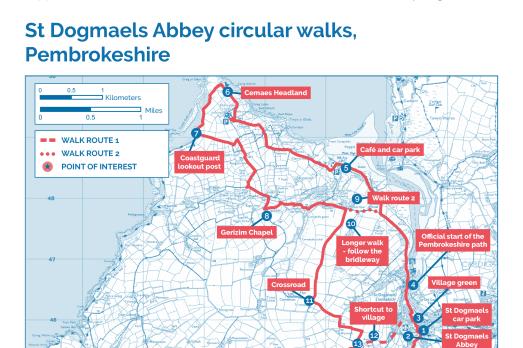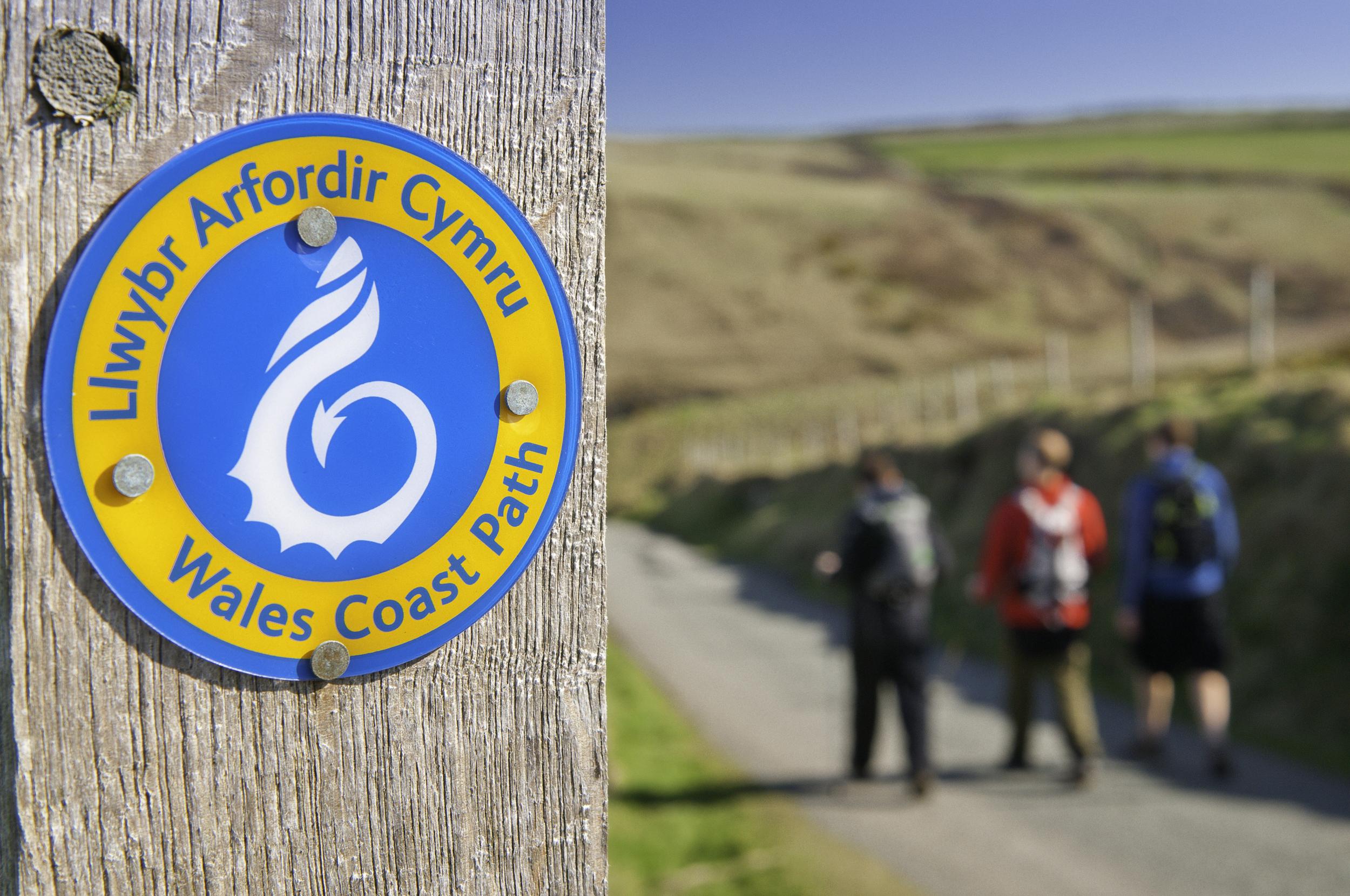
Wales coast path walks
870 incredible miles to enjoy, sampling incredible churches, along the Welsh coast
by Sarah Crossland, Engagement Manager
The Wales Coast Path is one of a few coastal footpaths in the world to follow a nation’s entire coastline.
While some rare souls may choose to walk the whole path, for the majority of us, the beauty is that you can simply walk whichever sections appeal. Dip in anywhere along its 870 miles and delight in jaw dropping views, contemporary cultural hotspots, unforgettable encounters with nature, and thousands of years of history.
The stunning coastal landscape of Wales has held allure for pilgrims, poets and travellers for millennia. Hundreds of ancient atmospheric Welsh churches are sited within a stones throw from, and even occasionally on, the beach, promontory or headland. Teetering on clifftops and sunk low on beaches, hidden deep in valleys and high up on soaring hilltops.
We've teamed up with the Wales Coast Path team to create 9 new trails, all visiting sacred places along the path.
Join us on our exploration of sacred Wales.
Back to trails page
Pilgrimage
Pilgrimages offer a sacred escape - a chance for spiritual renewal or a journey into quiet, less-travelled landscapes. They invite reflection, nurture wellbeing, and provide moments of calm away from the relentless pace of modern life. For some, pilgrimage is a deeply personal exploration of faith; for others, it is an opportunity to discover the rich heritage and history woven into sacred places. Wales is home to several pilgrimage routes, many of them connected by this path.
No matter where you are in Wales a peaceful pilgrimage, rich in culture, heritage and natural beauty is never far away. Discover a new blog about the pilgrimages along the Wales Coast Path website.
Llŷn Peninsula and Clynnog Fawr
Explore : Neolithic monuments, rocky shores and a super sized place of pilgrimage
Start and finish : St Beuno, Clynnog Fawr
Distance : just under 1 mile or 1km (the church, Bachwen Burial Chamber and the beach are all within this distance)
Wild and wondrous with some of the most beautiful and unspoilt beaches anywhere in the world, this stretch of coastline and its ancient sacred history rewards exploration.
St Beuno, descended from the royal princes of Powys, was the most celebrated of the early Christian monks of North Wales and it was he who founded the 'clas' at Clynnog Fawr in 616 and died here in about 640. A clas was an institution peculiar to the Celtic church, being a mixture of monastery and college; a place of prayer, teaching, ministry and mission.
Clynnog Fawr rapidly became an important ecclesiastical site, and was also a stopping place for those on pilgrimage to Bardsey Island. Sometimes known as the 'Island of 20,000 Saints', Bardsey was a hugely popular destination for pilgrims in medieval times, with three pilgrimages there being the equivalent of one to Rome.
Clynnog Fawr itself became a place of pilgrimage. The holy well near the church was said to have curative properties, and people spending the night on St Beuno's tomb were said to be healed.
Don’t miss the dog tongs and the intriguing 10th century sundial in churchyard, a relic from a time when clocks were unknown.
It's hard to beat the glorious atmosphere at St Beuno, Clynnog Fawr.
Mynydd Mawr to Aberdaron
Explore : a spectacular walk around the tip of Llŷn to a historic church on the shores of the Irish Sea
Long walk option : Mynydd Mawr to St Hywyn, Aberdaron is 4.5 miles or 7km one way
Shorter walk : Porthmeudwy to St Hywyn, Aberdaron is 1.5 miles or 2.5km one way
Begin your journey at the summit Mynydd Mawr, home to some of the best views on Llŷn. Gaze out across the waves to spot emerald coloured Bardsey, the 'Island of 20,000 Saints'. On a clear day and you can even see the peaks of Ireland’s Wicklow Mountains on the other side of the Irish Sea.
Look north and you’ll see the small peaks of a rugged coastline, to the south is the gloriously flat and sparkly five mile long Porth Neigwl beach. Early summer is an amazing time for the wild flowers along this stretch of coast, with thrift, rock rose, sea squill, campion and much more.
St Hywyn, Aberdaron was established in 516AD by Hywyn a cousin of Cadfan who built the monastery on the sacred island of Bardsey. The church is full of light reflected off the sea. There are the gravestones of Roman Presbyters from the 6th century, who brought Christianity to this remote corner of Wales. It was also the last parish of RS Thomas poet and priest, one of Wales greatest poets writing in English.
The stone church was built in the 11th century as the final rest place for pilgrims before crossing the treacherous waters to Bardsey Island. In the 21st century it is still a place of refuge, restoration and prayerful peace for the modern pilgrim and tourists on their own spiritual journeys.
Harlech to Llanbedr via Llandanwg
Explore : wonderful wildlife and a magical church hidden among rolling dunes
Start : Harlech Beach car park
Distance : 4 miles or 7 km one way
The Morfa Harlech National Nature Reserve is one of the most important dune systems in the country and a haven for plant and animal life. In spring and summer you might spot colourful maiden pink or rare bee orchids, alongside nesting ringed plovers, skylarks and stonechats, while autumn brings an array of unusual fungi and wading birds like oystercatchers, dunlins and sanderlings.
The ancient church of St Tanwg, Llandanwg is quite knitted into the sand dunes. It is reputed to have been founded in the 5th century by St Tanwg and is one of the oldest Christian foundations in Britain. It has been frequently dug out of the sand, which constantly encroaches and buries it. From inside the simple stone walls you can hear the waves on the beach even on the stillest of days.
In the churchyard lies the grave of the Welsh poet, Sion Phillips, a contemporary of Shakespeare, who lived at nearby Shell Island. He was drowned whilst crossing to Llandanwg in 1620.
It is a place widely acknowledged to be ‘thin’, rooted in the earth but within easy reach of heaven. It is a refuge of solace, simplicity and peace.
Mwnt circular walk
Explore : abundant marine wildlife, stunning sea views and a serene place of pilgrimage
Start and finish : Mwnt National Trust car park
Distance : 1.5 miles or 2.5 km circular walk
Enjoy a spectacular section of the Wales Coast Path, walking over a simple stone bridge and passing an old lime kiln as you head on to the clifftop. There are wide, glorious views in every direction. Look north across the water and you’ll see the long arm of the Llŷn Peninsula stretching out into the sea, while the grassy mound of Foel y Mwnt sits behind you and the small uninhabited Cardigan Island lies in front a little way along the coast.
Carry on along the coastal path, keeping an eye out for chough zipping through the air above and seals and dolphins playing in the waves below, before turning inland and heading through the fields back to your starting point.
Remember your camera. This is one of the most iconic places on the coast and the perfect place to watch the sun go down.
The Church of the Holy Cross, Mwnt has an intimate and ageless atmosphere.
A magnet for pilgrims for centuries, it still exerts a powerful pull today. Sat above a Bronze Age barrow overlooking the sands of Traeth Mwnt and the Irish Sea, the whitewashed stone building began life as a chapel of ease for sailors. It takes its name from the tall stone cross that once stood on nearby Foel y Mwnt hill, which served as a beacon for worshippers who travelled from far and wide to visit this pretty little church.
In medieval times, the bodies of saints would often stop here on their way to burial on Bardsey Island. As well as its picture perfect location, it’s packed with unusual historic features, including a rare 13th century font carved from Preseli stone.
Llangrannog to Penbryn
Explore : stunning coastal views on a rugged clifftop walk to an atmospheric 12th century church
Start : Llangrannog car park
Distance : 2.6 miles or 4 km one way
Follow a narrow lane winding up to the hill that overlooks the pretty beach and join the clifftop path at the statue of St Carranog, which keeps a constant watch over the bay. It’s a rugged path with plenty of testing climbs and descents, but the jaw dropping seaside vistas and the chance to spot seals, dolphins and seabirds are well worth it.
Before the church, the path leads into the wooded Hownant Valley. Also known as Cwm Lladron or Thieves Valley, it was a famous haunt of salt smugglers and herring fishermen.
St Michael, Penbryn is ancient. Raised up on elevated ground with glorious coastal views and fringed by ancient woodland, it’s setting takes the breath away. Penbryn is Welsh for 'hilltop' and the churchyard’s rounded shape indicates that early Christians established a religious site here.
The walls are whitewashed and stand out sharply against the blue Ceredigion sky. Head inside and you’ll discover a peaceful refuge with an abundance of fascinating historical features. Look up to see the perfectly preserved 15th century roof, one of only two of its kind in south Wales (you’ll find the other at Mwnt).
Llanrhystud circular via Llansantffraed
Explore : a circular walk of celebrated saints and stellar sea views
Start : Llanrhystud village
Distance : 6 miles or 9 km circular
Trace a long shingle bank before walking along the edge of clay cliffs overlooking the sea and past the ruins of the Craiglas lime kilns, atmospheric remnants of Ceredigion’s industrial past. You might also see the remains of old jetties which peek out of the water when the tide is low, as well as fantastic views of Cardigan Bay. Watch out for dolphins leaping from the waves.
St Ffraid, Llansantfraed is the nearest church to the supposed birthplace of St Non, mother of St David.
A church has stood here since the 12th century, though the only surviving reminder of its earliest days is the limestone font decorated with a band of rosette mouldings. Can you spot the delicately detailed beam in the porch roof which was reused from the medieval rood screen that would have separated the nave from the sacred chancel? In 1839 David Francis of Llanon rebuilt the church in the fashionable chapel like ‘preaching box’ style, where the congregation focused on the pulpit and the word of the preacher, rather than the sacred altar in the chancel.
St Non with her young son Dewi Sant, are depicted in one of the glorious windows. He is believed to have been born in Llanon and to have walked 6 miles daily from here to school at Henfynyw.
The birthplace of St Non is said to have been marked by a chapel, now ruined with an uncertain location. But notice the mounted stoop stone in the porch, this was brought here, from the site of Non’s chapel 40 years ago.
On the coastal plain between the church and the sea are the ‘Morfa Escob’, the Bishops Meadows. Bounded to the north and south by the Peris and Cledan streams, they are a rare survival of an ancient field system of strips known as ‘slangs’. Legend tells them to be a gift from St David in 1231.
Trefin circular walk
Explore : industrial heritage, ancient history and deep religious roots combine with unspoilt clifftop views and rugged, rocky shorelines
Start : Trefin car park
Distance : 4 miles or 6 km, can be shortened to 2.5 miles or 4 km
Head out of Trefin, to the remains of Aberfelin mill. Though it ceased operation in 1918, it has been immortalised in verse in ‘Melin Trefin’ by the late Archdruid Crwys, one of the best loved poems in the Welsh language. Climb up onto the rugged clifftop as the path traces the shoreline’s jagged twists and turns. Watch out for Trwyn Llwyd sea quarry where hedge banks burst with colourful sea pinks and campions in the spring.
At Pen-castell Coch you can spot an Iron Age fort, one of dozens of Neolithic sites found on Pembrokeshire’s stretch of the coast path. The path turns inland past Carreg Samson, an impressive Neolithic burial chamber steeped in legend and topped with a mighty boulder.
Close to the walk’s start point is Trefin Calvinistic Methodist Chapel. Founded in 1786 and rebuilt in 1834 it was once a significant centre of Welsh Methodism, though it’s now preserved as a museum by the local community and Presbyterian Church of Wales. Explore its time capsule interior of antique fixtures and fittings, peeling paint and creaking floorboards for an evocative glimpse into the past. Trefin is also home to a Baptist chapel, built in 1840 and rebuilt around 1870 as a branch of Croesgoch. But the village’s religious roots go even deeper. Trefin was once the site of a Bishops Palace, set out in the medieval period as part of the estate of the Bishops of St Davids. Thought to have been built by Bishop Thomas Bek in the late 13th century, its remains now lie hidden beneath the village’s streets.
Manorbier circular walk
Explore : unspoilt coastline featuring a 12th century castle, Mesolithic burial chamber and church with deep Celtic connections
Start : Manorbier beach car park
Distance : 3 miles or 5 km
Start in the shadow of Manorbier’s magnificent 12th century castle.
First visit the church, over a small stone bridge and along a wooded lane. From there continue to join the coast path at King’s Quoit, a Mesolithic burial chamber with a mighty capstone. This is some of Pembrokeshire’s wildest and most remote feeling landscape, with stunning sea views of Stackpole and Caldey Island. It’s worth taking a detour down the steep path down to Precipe beach to get a better look at the fossil rich red sandstone cliffs.
The church of St James the Great, Manorbier, overlooks the overlooks the sea and sands of the beach. The early Celtic Christians’ knack for picking the most striking and inspirational spots for their churches is clear here. It was founded as a monastery in the 6th century by St Pyr, the first abbot of Caldey Island and a man who left lasting marks on this part of Pembrokeshire.
The stone church with prominent west tower that stands here today was rebuilt in the 12th century, at the same time as neighbouring Manorbier Castle was erected by the de Barri family. It’s notable for its long nave, and inside you’ll find a medieval painted porch roof, a scalloped Norman font and the effigy of a knight from 1325.
There is modern stained glass depicting the landscape and the sea, a clear and colourful link with the church’s Celtic roots.
St Dogmaels circular
Explore : coast and countryside, with an array of significant religious sites and some of Pembrokeshire’s most spectacular clifftops
Start : St Dogmaels car park
Distance : Walk route 1 is 11 miles or 17 km, walk route 2 is 8.5 miles or 14 km
Take some time to explore the village, Abbey and Y Felin Water Mill. Carved into the 16th century doors are overlapping V's, ritual ‘Marian markings’ believed to be invocations to the Virgin Mary for protection. Water dashes over the waterwheel, timbers strain, stones grind and freshly milled flour tumbles into sacks.
Heading out of the village pass the place where historically, fisherman drew lots to decide which pools they would fish for salmon and sea trout (sewin). The village green was once filled with over 200 wooden posts (standards) used by fishermen to dry and repair nets, now only a dozen remain.
Walking along the coast path there are great views of Cardigan Island Nature Reserve. Further along at Cemaes Head Nature Reserve, on a good day, it’s possible to see Plynlimon, Snowdonia, the Llŷn Peninsula and Bardsey Island. Rounding Cemaes Head, the cliffs rise to over 574ft/175m, the highest in Pembrokeshire!
Named after a 5th century saint, St Dogmaels Abbey was built some 170 metres from the site of the ‘clas’ he founded. Look out for the distinctive 13th century stonework with alternating bands of local slate and sandstone rubble, a technique designed to create strong bonds that was inspired by the walls of Constantinople. Despite being closed and demolished in 1537 during Henry VIIIs Dissolution of the Monasteries, it provides many fascinating insights into the lives of the Tironensian monks who lived, worshipped and worked here.
Right next to the Abbey, you’ll find St Thomas’ church. Built in 1847 it’s home to the intriguing Sagranus Stone. Standing 7ft/2.1m high, this 5th century pillar stone is inscribed in both Latin and Ogam (the early Gaelic lettering system of Ireland) and is thought to have originated from the church of St Dogmael’s first monastery.

©CrownCopyright2020
Wales Coast Path
The Welsh coastline has many contrasts and really does offer something for everyone. From cliff top strolls to estuarine wanders, picturesque fishing villages to vibrant cities, industrial heritage to unconquered castles, desolate windswept beaches to bustling seasides. Whether you’re here for a single hour or an entire weekend, the Wales Coast Path has a lot to offer.
The Coastal Way
These walks also are along the Coastal Way.
The breath taking coastal landscape of Wales has held allure for pilgrims, poets and travellers for millennia. Hundreds of ancient atmospheric Welsh churches are sited within a stones throw from, and even occasionally on, the beach, promontory or headland. Your journey will lead you through some of the most awe inspiring landscapes in the world.
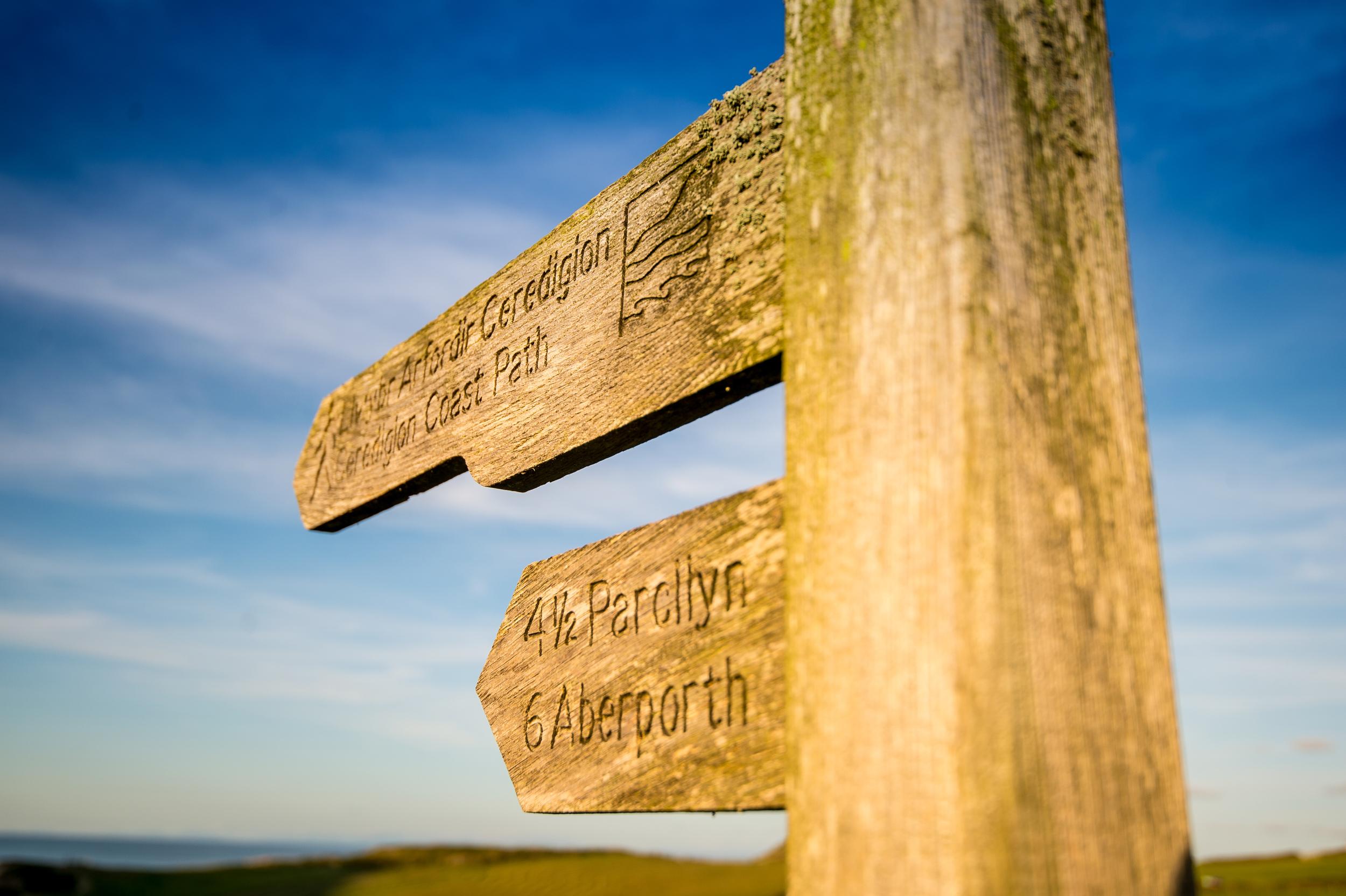
©CrownCopyright2020

